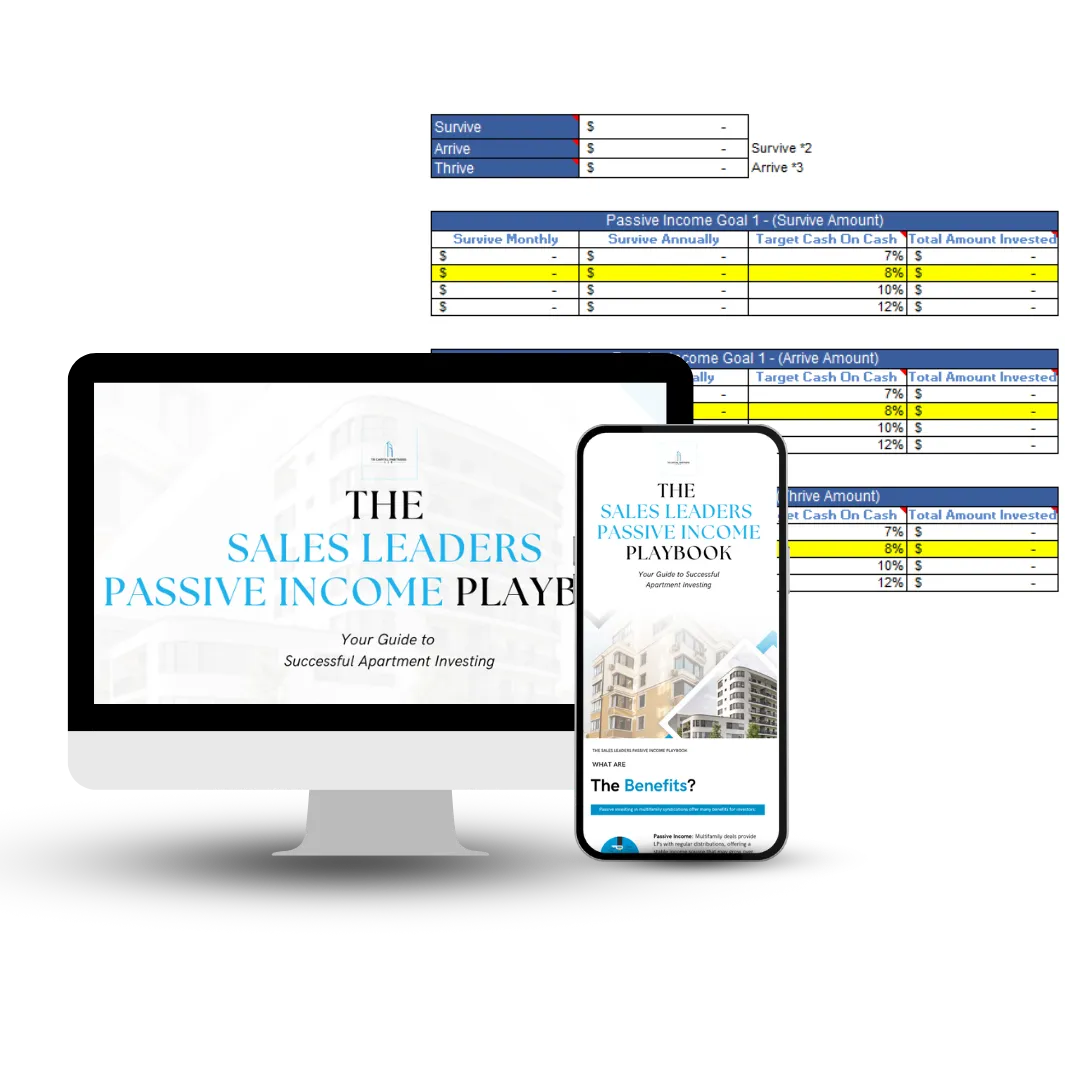
Your Top FAQs Answered!
We've helped over 400 investors scale their portfolio to grow their wealth and passive income through investing in our multifamily syndication opportunities. In order to help those who are interested in doing the same, we've compiled the
37 most FAQs about getting started.
What is multifamily real estate syndication?
Multifamily real estate syndication is a partnership where multiple investors pool their capital and resources to acquire large apartment complexes or multifamily properties. This allows investors (Limited Partners) to access deals that are typically too large or costly for one individual to purchase alone, while also being passive and not having to deal with the day to day operations a multifamily property requires.
How does the syndication model work for multifamily investments?
In the syndication model, a sponsor (General Partner) manages the deal, including finding the property, securing financing, and handling day-to-day operations. Limited Partners invest capital but remain passive, receiving a share of the profits, tax benefits, and equity growth without taking on management responsibilities.
What are my responsibilities and liabilities as an LP?
As an LP, your responsibility is limited to your capital investment. Your liability is also limited, meaning you are not personally responsible for the property’s debt or operational issues.
What is the role of the General Partner (GP) or Sponsor?
The GP manages the entire syndication, from sourcing the deal to financing, operations, management and eventual sale. They make all key decisions related to the property’s performance.
How does the GP manage the property, and what decisions do they make?
The GP oversees property management, capital improvements, leasing, and budgeting. They make decisions on financing, renovation schedules, and when to sell or refinance the property.
What are the expected returns on investment?
Returns typically range between 16-20% annually, depending on the deal. They come from a combination of cash flow, equity growth, and appreciation over the hold period.
What kind of cash flow, equity, or appreciation should I expect?
Investors can expect regular cash flow distributions from rents, appreciation from property value growth, and equity gains upon the sale or refinancing of the property.
How are returns distributed?
Returns are distributed according to the deal structure, often with a preferred return going to LPs first, followed by profit splits between LPs and GPs.
Will I receive monthly, quarterly, or annual payments, and how are they calculated?
Most syndications offer quarterly distributions based on the property's net operating income. Payments are calculated based on your share of the ownership in the syndication.
How long will my capital be tied up, and when can I expect a return of capital?
Your capital is tied up for the duration of the hold period, typically 3-7 years. You’ll receive the return of capital when the property is sold or refinanced.
What are the key risks, and how are they mitigated?
Key risks include vacancy rates, property damage, and market shifts. These are mitigated through careful property selection, strong property management, and maintaining cash reserves.
What is the minimum investment amount?
The minimum investment typically ranges from $25,000 to $100,000, depending on the syndication.
What kind of multifamily properties are typically acquired in syndications?
Properties range from value-add (needing improvements) to stabilized (performing well) assets, depending on the investment strategy.
How are multifamily syndication deals structured?
Deals are typically structured with an equity split between LPs and GPs, with the GP managing the investment while LPs provide the capital.
What is the typical equity split between LPs and GPs?
Equity splits commonly range from 70/30 to 80/20, where LPs receive the larger share and GPs earn a smaller percentage for managing the deal.
What is a preferred return, and how does it affect my investment?
A preferred return is a priority return on investment given to LPs before the GP receives their share of profits. It ensures LPs receive a base return before profit-sharing.
How does the preferred return benefit me as an LP?
It guarantees that you, as an LP, are paid a certain percentage of profits (e.g., 7-10%) before the GP takes their share, offering a layer of protection for your capital. This incentivizes the GP team to ensure performance of the asset.
How do I vet a sponsor or GP before investing?
Review their track record, experience, past performance, and communication style. Check for successful deals and their ability to manage multifamily properties effectively.
What qualifications and track record should I look for?
Look for a GP with experience in multifamily real estate, a strong history of returns, transparent communication, and a solid reputation among investors.
What fees are involved in syndications?
Fees may include acquisition fees, asset management fees, and disposition fees, which compensate the GP for their management and oversight of the deal. These fees will be outlined in the materials presented to the investor, prior to them making a decision.
What kind of reporting and communication can I expect from the GP
We provide monthly and quarterly updates and reports on property performance, financials, and any major updates or milestones.
How is the syndication structured from a legal standpoint?
Syndications are typically structured as LLCs, where LPs are passive investors and GPs are active managers.
What happens if the market turns, or the investment underperforms?
The GP may adjust the strategy, such as holding the property longer or refinancing. You could experience lower returns or an extended investment period.
How does the sponsor plan to handle market downturns or financial difficulties?
Strong sponsors have contingency plans like cash reserves, refinancing options, and conservative underwriting to weather downturns.
What tax benefits do I receive as an LP?
You benefit from depreciation, tax deferrals, and sometimes participation in 1031 exchanges, which can significantly reduce your taxable income.
Is my investment liquid, or can I sell my shares?
Multifamily syndications are illiquid, meaning you typically cannot sell your shares until the property is sold or refinanced. However, if needed, your shares may be bought out by another investors in case of emerency.
What happens if I need to exit the syndication before the end of the hold period?
Exiting early can be difficult, but some syndications allow you to sell your shares, often with GP approval or through a secondary market.
How do I ensure the investment aligns with my financial goals?
Compare the expected cash flow, appreciation, and timeline with your personal financial goals, risk tolerance, and desired returns.
How do I compare syndications to other investment opportunities like stocks or bonds?
Syndications offer long-term cash flow, equity growth, and tax benefits, while stocks and bonds are more liquid but may lack the same level of tax advantages.
What due diligence is conducted on the property before acquisition?
The GP typically conducts thorough inspections, financial analysis, market research, and rent growth forecasts before purchasing the property. You can access our due diligence checklist here.
How does the sponsor evaluate property location, rent growth, and financials?
Sponsors assess market conditions, population growth, employment rates, rent comps, and the property's historical financials to ensure strong potential returns.
What is the difference between Class A, B, and C multifamily properties?
Class A properties are high-end and newer, Class B properties are mid-tier and well-maintained, and Class C properties are older with value-add potential.
What is a capital stack, and where do LPs fit in?
The capital stack refers to the layers of financing (debt and equity) in a deal. LPs are in the equity portion, typically receiving returns after debt is paid.
How is the investment capital structured between debt, equity, and other funding?
Most syndications use a combination of debt (e.g., mortgages) and equity (LP and GP contributions) to fund the acquisition and operations.
What happens at the end of the investment term?
At the end of the term, the property is usually sold or refinanced, and profits are distributed to LPs, returning your initial investment and final returns.
Will the property be sold, refinanced, or recapitalized, and how does that affect me?
It depends on the deal strategy. A sale returns your capital and profits, while a refinance allows you to continue earning while pulling out some capital.
How do I start investing in multifamily syndications?
Start by vetting sponsors, reviewing investment opportunities, and ensuring the deal aligns with your financial goals and risk tolerance. To get started, schedule a call with our team.

Join our Investor Club
(it's free!) so you never miss an investment opportunity.
*Plus, you'll receive an exclusive copy of our SALES LEADERS' PASSIVE INCOME PLAYBOOK & our PASSIVE INCOME CALCULATOR.
